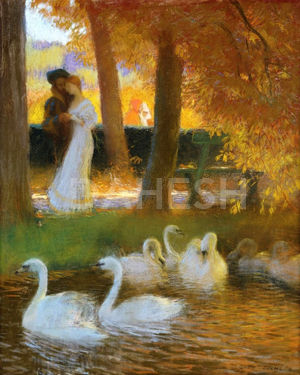Gaston La Touche (French, 1845–1913)
The Lovers and the Swans (Les Amants et les Cygnes), 1896
Pastel on canvas, 37 1/2 x 32 1/2 in. (glazed)
Signed lower right G. LaTOUCHE 96
1997.22

La Touche’s quick ascent to popularity was due in part to his gift as a colorist and his choice of subject matter, 18th-century celebrations and romantic encounters in beautiful parks. Both of these qualities take front and center stage in The Lovers and the Swans, a pastel drawing of a young couple as they stroll past swans on an autumn day. The romance of the image is palpable as the man leans in to speak to his paramour, and it is also reflected in the swans––enduring symbols of romance because they mate for life. La Touche became known for his frequent depictions of swans, often appearing alongside bathing nymphs, and he was characterized by his biographer Valmy-Baysee in 1910 as a “painter of beautiful and delicate light playing on water scarcely disturbed by the indolent gliding of swans.” The beautiful birds, tender romance and brilliant colors of The Lovers and the Swans, however, obscure a more banal reality, namely La Touche’s disdain for pastels. Speaking to a reporter from the New York Times in 1913, he commented “I seldom paint pastels now; I’ve had so much trouble with that medium; I have a horror of it.”


